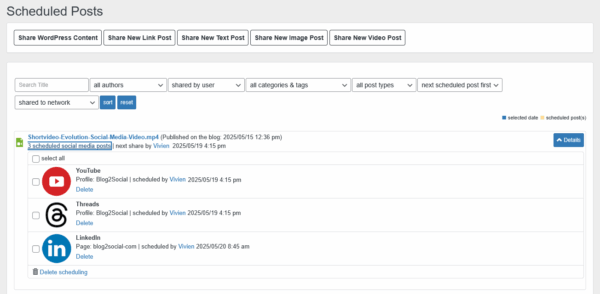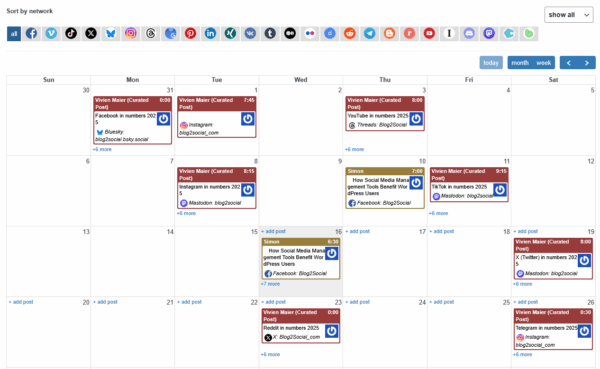Managing social media used to feel like a full-time job. Between scheduling posts, responding to comments, and tracking performance, it was a lot to juggle. But that’s no longer the case with new technology.
Social media automation is a time saver for marketers or brands managing multiple social media accounts. It helps streamline repetitive tasks like posting content, curating articles, or generating reports so you can focus on strategy, creativity, and real conversations.


In 2025 and beyond, managing social media is all about working smarter, not harder. Here are the key ways social media automation can help your B2B business grow, stay consistent, and keep up with the pace of digital marketing today.
What is Social Media Automation?
Social media automation means using tools to handle the repetitive, time-consuming parts of managing your social media presence. This automation is widely and commonly used for scheduling posts, responding to common messages, tracking analytics, or curating content.
Instead of manually posting every update or checking each platform daily, automation lets your team focus on strategy and creativity while the tools handle the grunt work. B2B businesses can stay active and consistent on platforms without having to log in every few hours.
The goal of using social media automation isn’t to “set it and forget it” but to free up your time so you can engage more meaningfully when it matters. There are more key benefits; here are some we can share:
- Time Savings: Streamline repetitive tasks like posting and scheduling.
- Consistency: Maintain regular posting even during off-hours.
- Improved Analytics: Track engagement and ROI efficiently.
- Lead Nurturing: Automate follow-ups and content delivery.
- Scalability: Manage more platforms without scaling up the team.
Use Cases for B2B Businesses
Managing social media for a B2B company can feel overwhelming, especially when you manage multiple platforms across time zones and audience segments. Here are essential cases of social media automation that are used by B2B businesses.
#1. Scheduling thought leadership posts.
Thought leadership is one of the most effective ways for B2B companies to build credibility by showcasing and demonstrating expertise. However, consistently sharing insightful content takes time and effort.
With scheduling tools, your marketing team can batch-create posts weeks ahead and schedule them to go live when your audience is most active. This helps maintain a steady flow of valuable content without the pressure of daily posting.


For example, Blog2Social enables you to plan and customize posts across multiple social networks in advance. It allows you to repurpose blog content into various formats and schedule posts at optimal times, ensuring a consistent and engaging presence.
You can mix it up, too: industry insights, explainer videos, repurposed blog snippets, or behind-the-scenes updates from your team. Thought leadership only works if it’s seen, and scheduling ensures that it happens regularly.
#2. Automating responses to FAQs or comments via AI chatbots.
Customer questions don’t always come in during office hours, and even when they do, your team might not have the bandwidth to reply to each one right away. That’s where automated responses and AI chatbots can step in to lighten the load.
Imagine someone asking on your LinkedIn page, “How do I request a demo?” or “Do you offer enterprise pricing?” With automation, you can program smart replies or trigger a chatbot that guides them to the right answer instantly.
These bots can be trained to handle common questions, direct users to resources, and even collect lead information for your to follow up later by your sales team. Reliable interaction helps you meet potential clients where they are without keeping them waiting.
#3. Retargeting cold leads through automated campaign sequences.
Not every lead you generate is ready to talk sales right away. Some just aren’t in the buying stage yet—they need time, information, and reminders.
Rather than letting those leads go cold, you can use automation to bring them back into the conversation through a carefully designed retargeting sequence.
After a lead downloads your content or attends a webinar, they might enter an automated campaign that sends a series of follow-up touchpoints over a few weeks. This could include educational posts, success stories from similar clients, product tips, or an invitation to a live Q&A.
You can do this across channels—email, LinkedIn, or even retargeted ads—without manually sending anything. The goal is to warm up those leads gradually and help them move closer to a buying decision at their own pace.
#4. Monitoring mentions and keywords in your industry.
Staying informed about what people are saying—about your brand, competitors, or key industry trends—used to require manual searching or endless scrolling. Now, automation makes this process way more efficient.
You can automatically track mentions of your company name, product, or specific keywords relevant to your niche. That means you’ll get notified when someone talks about you (good or bad), asks questions about your space, or starts a conversation you should probably be part of.
This kind of listening is incredibly valuable. You can jump in to answer questions, offer insights, or spot potential partnerships or sales opportunities before your competitors do. Plus, it gives you a clearer sense of how your brand is perceived.
#5. Onboarding and educating new leads with an automated content series.
Let’s say someone just signed up for a free trial or downloaded your lead magnet—what happens next? If you’re relying on a manual follow-up process, odds are they’re not getting the consistent, helpful experience they should.
You can set up a sequence that automatically guides new leads through a tailored onboarding journey. It might start with a welcome message, followed by a few emails or social posts introducing key features, success stories, or quick tips.
Where the sales cycle is often longer and more complex, this kind of nurturing builds trust and keeps your brand top-of-mind. Once it’s set up, it runs in the background, consistently educating and moving leads down the funnel without adding work to your team’s plate.
Takeaway
Social media automation tools help your B2B business do things smarter and more effectively. Beyond the day-to-day time savings, automation is reshaping how B2B companies understand and interact with their audiences.
Tools now offer predictive analytics, allowing you to anticipate engagement trends, optimize content formats, and fine-tune campaigns before they even launch. Finally, automation opens the door to personalization at scale—no more generic messages.
This kind of relevance turns a cold prospect into a warm lead—and a one-time buyer into a long-term client. When used well, it’s a strategic layer that can sharpen your marketing, deepen your relationships, and create space for your team to focus on what humans do best.
Andre Oentoro is the founder of Breadnbeyond, an award-winning explainer video company. He helps businesses increase conversion rates, close more sales, and get positive ROI from explainer videos (in that order).
Twitter: @breadnbeyond
Email: andre@breadnbeyond.com
LinkedIn: Andre Oentoro




